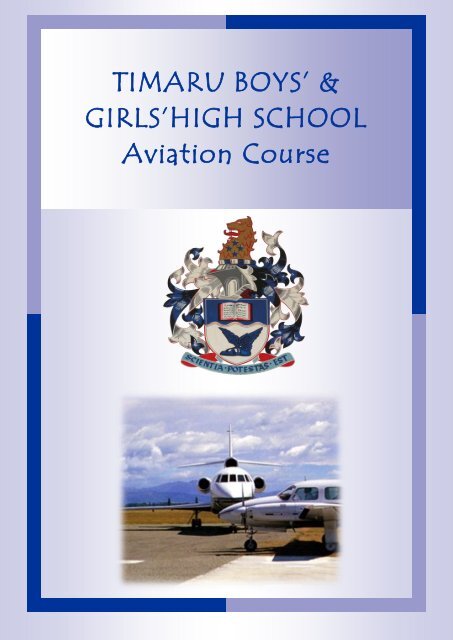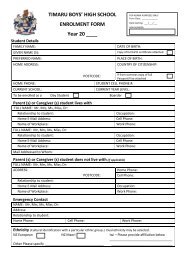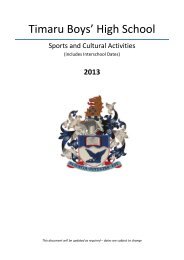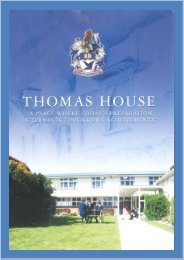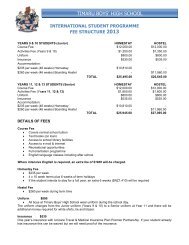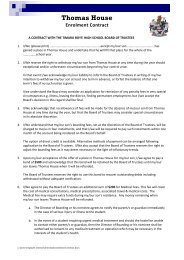TBHS & TGHS Aviation Course - Timaru Boys High School
TBHS & TGHS Aviation Course - Timaru Boys High School
TBHS & TGHS Aviation Course - Timaru Boys High School
You also want an ePaper? Increase the reach of your titles
YUMPU automatically turns print PDFs into web optimized ePapers that Google loves.
TIMARU BOYS’ &<br />
GIRLS’HIGH SCHOOL<br />
<strong>Aviation</strong> <strong>Course</strong>
INTRODUCTION....<br />
AN AVIATION FLYING OPPORTUNITY<br />
<strong>Timaru</strong> <strong>Boys</strong>’ and <strong>Timaru</strong> Girls’, in conjunction with<br />
South Canterbury Aero Club are very pleased to offer<br />
an aviation course to senior students. Students have<br />
the opportunity to attain a Private Pilot Licence (PPL)<br />
in fixed wing (aeroplane) while studying for their<br />
national academic qualifications.<br />
The timetable structure at <strong>Timaru</strong> <strong>Boys</strong>’ and Girls’ will<br />
allow students to have normal classes and aviation<br />
theory during the course of the school day and after<br />
school or weekends the students will gain practical<br />
flying experience under the care of the South<br />
Canterbury Aero Club.
COURSE APPLICATIONS<br />
The course will be limited to students in Year 11,<br />
12 and 13, however you cannot fly solo until age 16<br />
and cannot gain the Private Pilot’s Licence (PPL)<br />
until age 17.<br />
Students must pass a Class 2 medical examination<br />
before being accepted on the course.<br />
There are a limited number of places available in<br />
the course each year. Students must complete the<br />
enclosed application form and submit it to <strong>Timaru</strong><br />
<strong>Boys</strong>’ or <strong>Timaru</strong> Girls’ as soon as possible as spaces<br />
are limited. Please ensure that you send all the<br />
required documentation as outlined on the application<br />
form.<br />
You must be enrolled at <strong>Timaru</strong> <strong>Boys</strong>’ <strong>High</strong> <strong>School</strong><br />
or <strong>Timaru</strong> Girls’ <strong>High</strong> <strong>School</strong> by the start of the<br />
school academic year before being accepted on the<br />
course.
SOUTH CANTERBURY AERO CLUB<br />
Students will be trained by highly qualified<br />
members of our local Aero Club<br />
The club employs one full time Category "B"<br />
instructor who usually has the services of two or<br />
three honorary Category “C" instructors as<br />
required. All instructing staff hold Commercial Pilot<br />
Licences plus Instructor Ratings issued by the NZ<br />
Civil <strong>Aviation</strong> Authority. All instructors receive an<br />
annual "competency" check carried out by their<br />
Check and Training Organisation.<br />
A fleet of two Piper Tomahawk trainers and one<br />
Piper Archer are operated by the club. They have a<br />
collective value of around $200,000. The aircraft<br />
undergo rigorous<br />
maintenance<br />
every 50 hours to<br />
ensure the<br />
highest possible<br />
standard of<br />
safety.
PROGRESSION CHART<br />
Trial Flight For those who have not flown before to see how they like<br />
it.<br />
Effects of Controls - How the aircraft is controlled in flight and on the<br />
ground.<br />
Straight and Level - How to attain, recognise and maintain straight and<br />
level flight. Simple, but very important for accurate flight.<br />
Climbing and Descending - How do we take the aircraft from straight<br />
and level and put it into a climb, or a descent.<br />
Turning - How to turn the aircraft.<br />
Stalling - What happens when we fly too slowly, we stall. A very<br />
straight forward exercise and easier to do than most people think.<br />
With the “Basic" part of the training covered we now move on to<br />
combining everything we have learnt.<br />
Circuits - How do we take-off, fly around the aerodrome, and land.<br />
Circuit lessons continue until the student is proficient. We look at what<br />
we do if we decide for any reason not to land (over-shoot), and how to<br />
cope in the very unlikely event of an engine failure during/after<br />
take-off.<br />
First Solo - You are now capable of flying yourself so off you go. Your<br />
first solo usually consists of one circuit. The biggest thrill of your life.<br />
Solo Consolidation - A few hours spent in the circuit on your own with<br />
the occasional dual check<br />
with an instructor.<br />
Now the Advanced Dual/Solo<br />
training starts. It is<br />
recommended that students start<br />
thinking about ground studies by<br />
now.
Progression chart<br />
Circuit Re-joining – How to re-join the circuit in an approved manner, at an<br />
un-controlled aerodrome.<br />
Forced Landings Without Power - If ever something goes wrong you will<br />
need to know how to get yourself down safely. With set procedures<br />
followed it soon becomes second nature.<br />
Steep Turns - If we need to turn in a hurry, a steeper bank angle is<br />
required - we will show you how this is done.<br />
Advanced Stalling - The aircraft can be stalled in more than one way, the<br />
student needs to know how to recognise and recover from any stall.<br />
Slow Flight - Learning the low speed handling of the aircraft<br />
Compass Turns – To turn on to selected headings using a magnetic<br />
compass.<br />
Short Take-off and Landing - Make the aircraft perform to its limit in both<br />
take-off and landing. A must for those shorter strips.<br />
Cross Wind Circuits - If you arrive back at the aerodrome and a cross wind<br />
has sprung up it is nice to know you can cope, we show you how.<br />
Low Flying - In bad weather we must be able to (if we have no other<br />
choice) navigate at low level in bad visibility.<br />
Instrument Flying - A few years ago Civil <strong>Aviation</strong> included five hours of<br />
instrument training in the syllabus to combat a high number of bad<br />
weather accidents. While avoiding bad weather is the best solution, a basic<br />
knowledge of instrument flying may one day prove helpful.<br />
Mountain Flying – Low level flying in valleys. Learning how to make valley<br />
turns, cross ridges and read the weather in the mountains.<br />
Cross Country Flying - How to plan and carry out a cross country is<br />
essential for any pilot wishing to go places. A minimum of 5 hours dual and<br />
five hours solo is required. Most exams are required prior to cross country<br />
flying.<br />
Revision for flight test.
Scenic routes<br />
From the peak of Aoraki Mount Cook to the sandy beaches of Caroline Bay, in<br />
rolling hill country, sweeping plains and braided rivers, South Canterbury in the<br />
Central South Island of NZ is fresh, vibrant, forward-looking and full of surprises.<br />
Flying in this region provides opportunities of unequalled scenery and beauty<br />
that include:<br />
Aoraki Mount Cook: This 3755m peak is the highest mountain in New<br />
Zealand and centred in the Mt Cook National Park- surrounded by the<br />
panoramic MacKenzie Country, Tasman Glacier and Lakes Pukaki, Tekapo<br />
and Ohau<br />
Lake Tekapo: This highland lake and settlement at 710 metres (2,300 feet)<br />
is in the heart of the Mackenzie District and surrounded by a vast basin of<br />
golden tussock grass. The name Tekapo derives from Maori words<br />
Taka (sleeping mat) and Po (night). Finely ground rock in the glacial melted<br />
waters give Lake Tekapo a beautifully unique turquoise colour.<br />
<strong>Timaru</strong> by air: Within the gentle curve of the South Canterbury coastline<br />
the <strong>Timaru</strong> District covers 2,602 square kilometres of diverse landscape. Attractive<br />
towns, lush pasture, rolling downlands, green hills and clean rivers<br />
lie in the lee of New Zealand's magnificent Southern Alps in the west.<br />
The District's north and south<br />
boundaries are naturally defined by<br />
two rivers, the Rangitata and the<br />
Pareora, both known for good fishing<br />
and swimming. A stretch of land in the<br />
northwest sweeps through 64 km of<br />
dramatic scenery beyond the Rangitata<br />
Gorge to Mesopotamia Station in the<br />
high country.
cost<br />
FEE PAYABLE TO: AMOUNT<br />
South Canterbury Aero Club<br />
Annual Membership Fee<br />
Medical Exam Application<br />
Fee<br />
South Canterbury Aero Club $150<br />
Civil <strong>Aviation</strong> Authority $313<br />
Class 2 Medical Exam Medical Practitioner $300<br />
Exams<br />
Radio, Human Factors, Meteorology,<br />
Navigation, Law,<br />
Air Tech: $83 each<br />
ASL: Assessment Services Ltd $498<br />
ICAO English Exam ASL: Assessment Services Ltd $122<br />
Equipment:<br />
Logbook, set of PPL Text<br />
Books, navigation computer,<br />
aviation ruler and protractor<br />
Flying:<br />
Minimum of 50* flying<br />
hours at $187 per hour +<br />
briefings<br />
South Canterbury Aero Club $474<br />
South Canterbury Aero Club $10,050<br />
Airways and Landing Fees South Canterbury Aero Club $300<br />
PPL Flight Test Fee South Canterbury Aero Club $295<br />
TOTAL: $12,502<br />
A minimum of 50 flying hours is required for a licence however a more realistic<br />
amount is 55-60 hours for the average student<br />
$ quoted in New Zealand dollars


